Grand Theatre of Quebec: Preserving a historic mural and Quebec’s culture through encasement conservation
Case Study Prepared by Nishi Prajapati, Carleton University
Keywords: Encasement Conservation, Sustainable Design, Cultural Heritage, Quebec City, Revitalization, Adaptability, Social Sustainability
- Lessons Learned
- Description
- Timeline
- Rightsholders and Stakeholders
- Heritage
- Sustainability
- Assessment and Measurement
- Works Cited
Lessons Learned
The Grand Theatre of Quebec set out to democratise the performing arts in Quebec’s capital city. Since the culture of Quebec is unique compared to the rest of Canada, the region developed its own collective set of beliefs/values surrounding arts, literature, institutions, and traditions. In 2017 when the rehabilitation of The Grand Theatre of Quebec was completed, it demonstrated how the integrated design and delivery process of the project was essential to ensure the long-term sustainability of Quebec City’s modern heritage. The rehabilitation allowed it to continue preserving Quebec’s culture through its programming.
The Grand Theatre conservation project encountered complications along the way. Firstly, due to the iconic but fragile mural that is connected to the exterior concrete panel; vibrations and other potential impacts to the envelope during construction had to be avoided. Furthermore, due to the requirements that the theatre maintain daytime and evening operations during construction work, the individuals coordinating this project had to ensure the generation of noise control solutions as to not impact rehearsals, performances, or block building accesses. For this reason, encasement was chosen as a vibration-minimizing conservation method. This innovative approach contributes to the advancement of practices when it comes to challenges such as site circumstances and unique constraints posed by the preservation of modern heritage.
Only a diverse team consisting of mechanical engineers, structural engineers, architects, and architectural historians were able to tackle the intricate nature of this project. Through thorough research and knowledge, each discipline had to find an inventive solution to reduce the impact of the intervention and pay homage to the original architect’s work. Complexity surrounding the logistical, time, and physical constraints from a structural point of view with regards to The Grand Theatre of Quebec, meant that a transdisciplinary team was required to produce a sustainable and innovative solution.
Presentation
This presentation was made in class on December 1st. It includes a brief summary of the main findings from this case study.
Description
Opening in December of 1970, Le Grand Theatre de Quebec inaugurated a vibrant arts and culture scene in Québec. It was designed by Polish-Canadian architect Victor Prus and is composed of two halls: Salle Louise Frechette and Salle Octave Cremazie. Chosen by Prus, three of the exterior walls exhibit a monumental mural designed by painter, ceramic artist, sculptor and muralist Jordi Bonet. The site is located at the final point of the extension planned government buildings on Parliament Hill; so Prus understood the physical constraints of the site. Prus utilized logic and clarity to meet the requirements of the complex and design a compact building in the brutalist style. As a result, the theatre complex houses 49 classrooms, 70 teaching and practice studios, a multi-media centre and a library that includes more than 60,000 documents of books, scores, monographs, periodicals, and recordings. Through the years significant deterioration to its building systems and exterior façade . The existing concrete envelope suffered from migration of moisture which led to condensation and rust issues. One of the aspects most impacted by the crumbling pre-fabricated concrete was a culturally significant piece of art on it’s walls – the mural by Jordi Bonet recognized in the history of Quebec art.
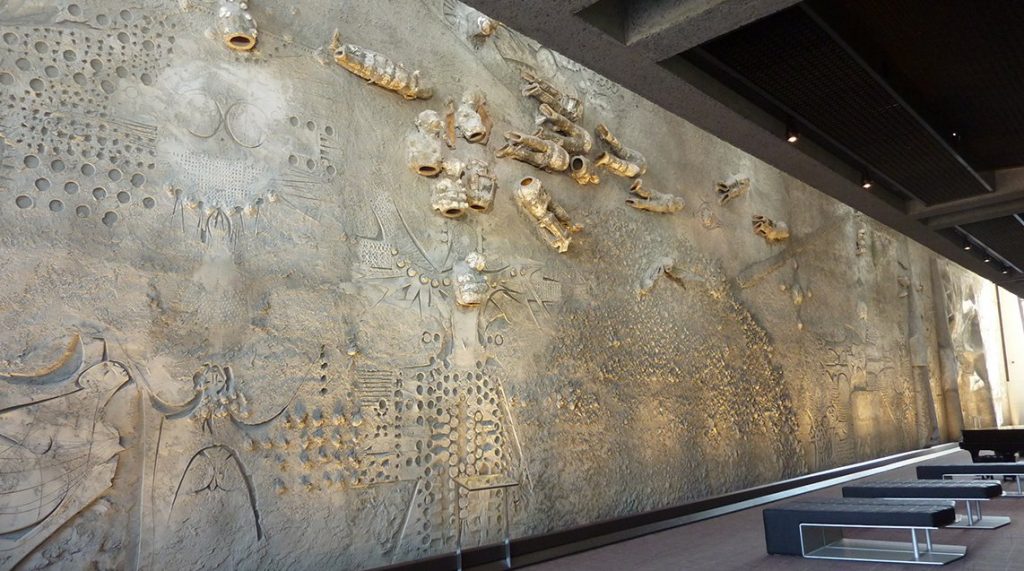
“Similar to a play having been written 50 years ago, we had to revitalize The Grand Theatre using anew script that would resonate with a new generation, all while respecting and embracing Prus’ original work.”
– Architect and Lemay Design Principal Eric Pelletier
Architects at Lemay and Atelier 21 developed the plan for a glass curtain wall and steel frame all around the building which would preserve both the brutalist style building by Victor Prus and the mural by Jordi Bonet. The new envelope is made up of 900 ultra-clear laminated glass infill panels supported by a steel cage. Since the existing basement had offices and technical rooms, architects were not able to build new foundations to support the added weight. By adding cantilevered supports, the new structure was secured to existing pillars to rest the added loads on the Grand Theatre’s current foundation. This design approach cleverly reduced the use of concrete, and no site excavation was necessary.
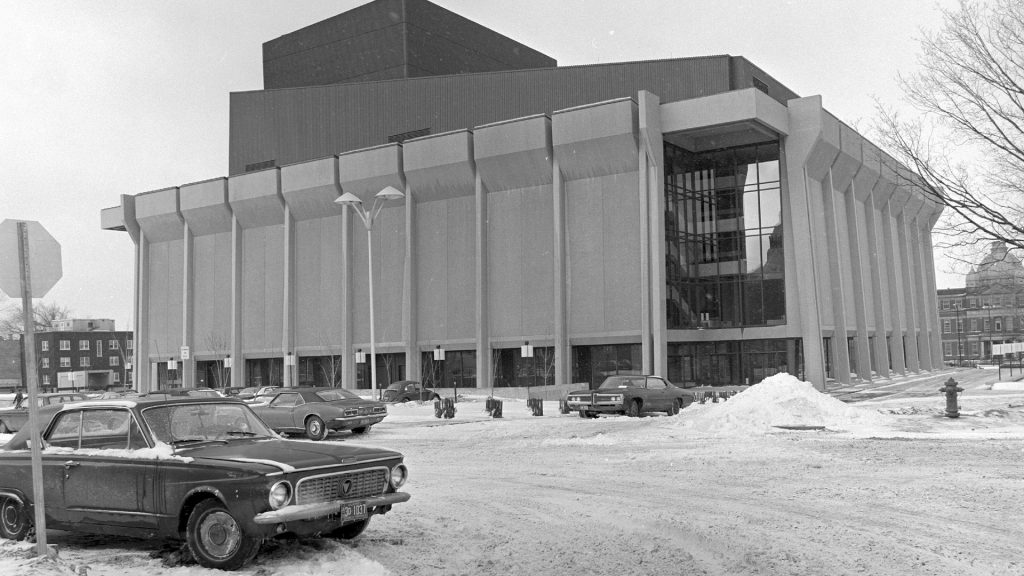
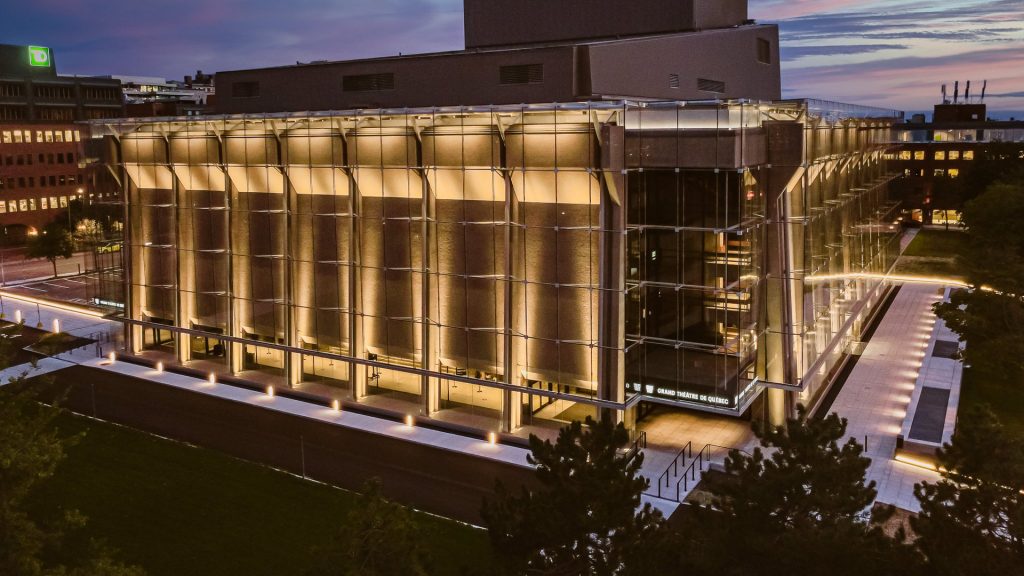
Timeline
In 1963, the Quebec government decided to establish the Grand Théâtre de Québec. Its mission was to develop and democratize the performing arts in the capital. Stemming from the Quiet Revolution (1960-1970) – which was characterized by a period of socio-political and cultural change in Quebec, many state-run welfare programs were given the opportunity to be established. The Quiet Revolution impacted the creation of the site and had long-lasting effects on Quebec’s cultural heritage.
The Quiet Revolution was fundamental in carrying out or planning many reforms, including economic reform, societal empowerment of nationalism, education reform and the path to secularization. This incredibly innovative time period for Quebec saw every aspect of society come under scrutiny. The Québec state took control of all social, health and educational institutions, taking it out of the hands of the Catholic Church. The cultural policy: Ministere des Affaires culturelles du Quebec (MACQ) created the ministry of Cultural Affairs to ‘favour and promote the specific cultural character of Quebec in the fields of arts, letter, and heritage’ (MACQ 1961) and affirm French-speaking Canadian identity. This department was responsible for the initiative to commemorate the Canadian Centennial through a major cultural project and laying the foundations for The Grand Theatre of Quebec. When presenting the MACQ bill to the National Assembly Premier Jean Lesage declared, “Government does not create culture, neither does it control it … it merely attempts to create a climate in which the arts may flourish” (Potvin, 2013)
Organizational history
| 1963 | Announcement of the start of the search for a major cultural project for Quebec |
| 1964 | Victor Prus (lead architect) begins designing the space as functional architecture in a brutalist style. Prus entrusts Jordi Bonet with the design of a mural that covers three of the interior walls of the Grand Theatre |
| 1965 | Project is named The Grand Theater of Quebec, inspired by the particular character and culture of Quebec |
| 1969 | Jordi Bonet and his team complete the mural that adorns the walls of The Grand Theatre. |
| 1970 | The first management team of The Grand Theatre is appointed. |
| 1978 | Presenting a wide range of performing arts, the Grand Theatre raised public awareness of the theatre, opera, and classical music. |
| 1987 | Changing spectator behaviour led to development of more sophisticated marketing strategies and merging the Grand Theatre ticketing system with the City of Quebec’s, forming the largest box office in Quebec. |
| 1990s | This decade saw the democratization of the performing arts and artistic mediation. |
| 2000s | The Grand Theatre develops programming aimed at a young audience and maintains efforts to sustain diversified programming. |
| 2010s | The Grand Theatre continues to offer programming focused on excellence Quebec and international performing art. |
| 2020s | Increasing digital world sees the Grand Theatre partner with Telus to create STUDIOTELUS which aims to promote performing and digital arts in Quebec. |
Physical building project
| 1963 | Locating a site for the project. |
| 1964 | Architectural competition is launched by The Ministry of Cultural Affairs, selection of Victor Prus. |
| 1966 | Conservative political party in power at the time (Union Nationale) and they bring modernizations projects like the theatre to a standstill. Construction is halted. |
| 1967 | After a year, construction of the project is relaunched. |
| 1969 | Work is halted once more after the announcement of a construction strike. |
| 1971 | Inauguration of the Grand Theatre. |
| 2000s | Signs of deterioration appearing on the pre-cast concrete panels on the exterior of the building. The Grand Theatre carries out modernization work of the two halls and preventive maintenance work. |
| 2017 | The façade of the building faces irreversible damage. Conservation and rehabilitation of the site takes place to ensure durability of Jordi Bonet’s mural and improve aging energy systems. |
Rightsholders and Stakeholders
The Grand Theatre of Quebec rests on traditional unceded territory of the Huron-Wendat Nation.
The creation and maintenance of this site includes various stakeholders. Key Organizations lists the groups that have a large stake in the theater’s creation and continued well-being. Owners and users of the site are people who are fundamental to the theatre’s purpose of showcasing performing arts. Other stakeholders include the architecture firms and companies that provided support during the rehabilitation and maintenance work to extend the lifespan of The Grand Theatre of Quebec.
Key Organizations:
- Ministry of Cultural Affairs
- City of Quebec
- Province of Quebec
- Grand Theatre of Quebec Society
Owners/User:
- Orchestre symphonique de Québec (Québec Symphonie Orchestra)
- Current artists and performers at the theatre
- General Public
- StudioTelus
Rehabilitation work:
- Lemay
- Atelier 21
- Pomerleau
- WSP
Heritage
When speaking of heritage of the Grand theatre of Quebec, we are truly speaking of the intangible cultural heritage of Quebec. As defined by UNESCO, intangible cultural heritage is: “traditional, contemporary, and living at the same time. Intangible cultural heritage does not only represent inherited traditions from the past, but also contemporary rural and urban practices in which diverse cultural groups take part.” Furthermore, “it contributes to social cohesion, encouraging a sense of identity and responsibility which helps individuals to feel part of one or different communities and to feel part of society at large” (UNESCO).
The theatre is a physical manifestation of Quebec’s cultural heritage and has helped to foster talents and notable artists throughout its long history. A great example of this is The Quebec Symphony Orchestra who performed at the inauguration ceremony in 1971 and although has seen many different music directors over the years; continues to perform at the theatre today. As well, the theatre contributes to raising public awareness of theatre, opera and classical music by welcoming leading French artists, variety shows and dance performances.
Indigenous heritage and Value: The Grand Theatre of Quebec rests on traditional unceded territory of the Huron-Wendat Nation. In addition to the Quebecois cultural heritage that The Grand Theatre upholds, it also supports Indigenous heritage through artists and performers at the theatre. One such show is Maudit Silence (staged in 2022) which brings together 18 poems from the three Americas, in 13 indigenous and Creole languages. Staging for this show has been done by Emilie Monnet who is Algonquin/French and calls upon George Wahiakeron Gilbert, a First Nations artist to ensure the narration of the sequence between the multilingual songs.
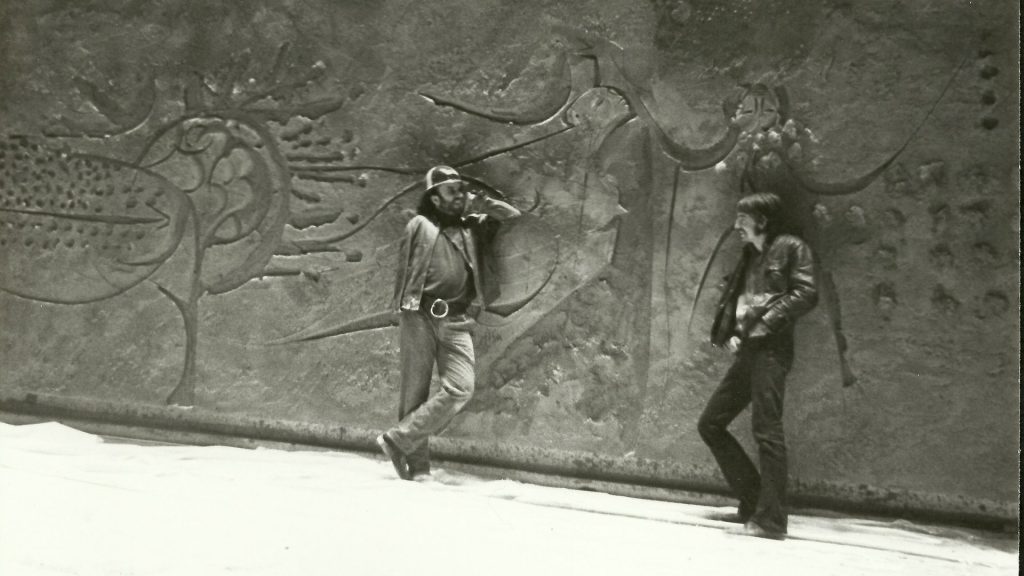
Jordi Bonet (left) pictured during the construction of the mural. Source: Grand Théatre du Québec.
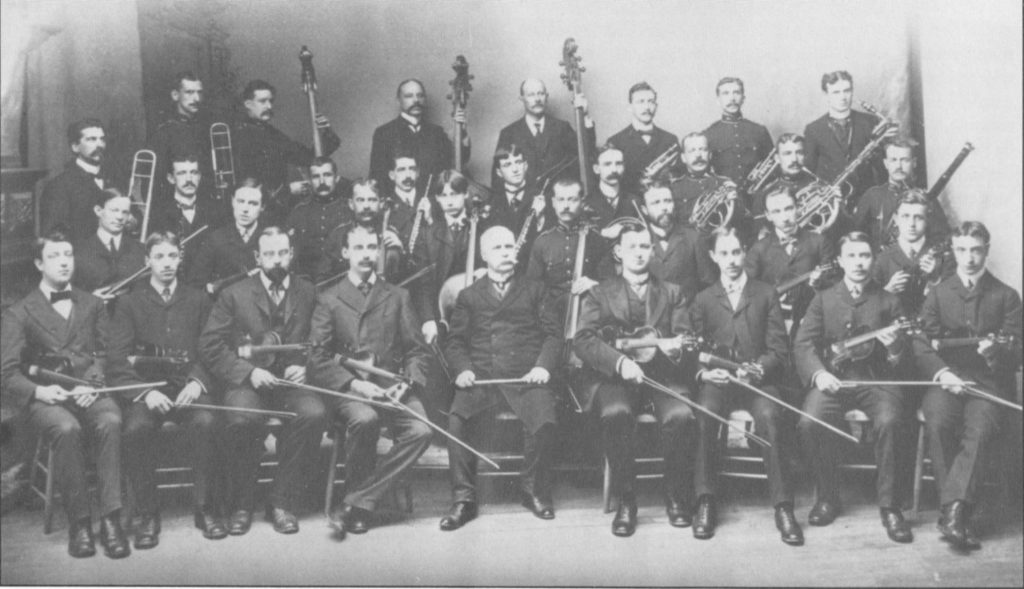
Pictured above is the first Quebec Symphony Orchestra in 1902. Photo courtesy of Société historique de Québec archives.
Sustainability
Environmental Sustainability: In early plans to find a site, careful consideration was given to where the Theatre would ultimately end up. Many sites were considered including Cartier-Breboef Park, land of the Villa Manrese, and Victoria Park. The advisory committee rejected the proposals received due to costs, infrastructure, and existing conditions of all these sites. In the end, it was decided that the site would be near Parliament.
Through the rehabilitation process, the curtain wall design created a protective outer shell for the existing building. It also allowed for the creation of a secondary envelope that houses a low-flow heat recovery and thermal mass system. Through the secondary envelope, The Grand Theatre was able to create a temperature-controlled barrier where the interior temperature and humidity levels are constantly regulated, thus creating the perfect conditions for Jordi Bonet’s mural. The construction process utilized the existing building and did not employ the use of any demolition which reduced the need for new materials.
Social Sustainability: Contributing to social sustainability, STUDIOTELUS was opened at the Grand Théâtre de Québec as a new multifunctional and versatile space for creation of digital and performing arts. This space has become a hub or practicing and emerging artists from the Quebec scene to work together and make use of the state-of-the-art stage equipment. The purpose of the space is to become a meeting space for creators to experiment with their art before putting it out into the world. STUDIOTELUS makes the Grand Théâtre a leader in the production, distribution and promotion of artistic practices that are both audacious and accessible.
Cultural Sustainability: The Grand Theatre has succeeded at maintaining artistic continuity through the ages with recurring performances by groups such as the Quebec Symphony Orchestra who resided at the Grand Theatre since the inauguration 50 years ago. The Theatre has also been praised for changing with the times and offering different programming through the years. Diversifying the programming enabled them to reflect the more diverse and international culture that Quebec now consists of. In the 1990’s The Grand Theatre was used as a birthplace of artistic mediation, which is the insertion of art and the artist’s voice into the larger cultural dialogue for the purpose of mediating or intervening in the forces of social and political events in Quebec.
Architecture and art are also physical pieces of cultural sustainability. Culturally important to its era, Brutalist building style and the mural by Jordi Bonet are both significant. Built by prominent architect Victor Prus, many of the character defining elements of Brutalism like sense of mass, scaling, showcase of structural elements and concrete forms were able to be conserved, as well as Bonet’s mural. The rehabilitation created continuity with the original design of the building and allowed for it to be viewed in a new perspective.
Economic Sustainability: A complication early in the conservation project process was that the Theatre was to remain operational throughout all construction work. Although a challenge, the team at Atelier 21 and Lemay architect came up with a project plan that was minimally invasive and highly thoughtful of day-to-day operations at the theatre. They were able to complete all conservation and construction work without disruptions to regular performances and events. Most importantly, the theatre supports the local economy of Quebec City through employment of staff; and ticket sales of music, theater, dance, opera, speech art, and variety shows.
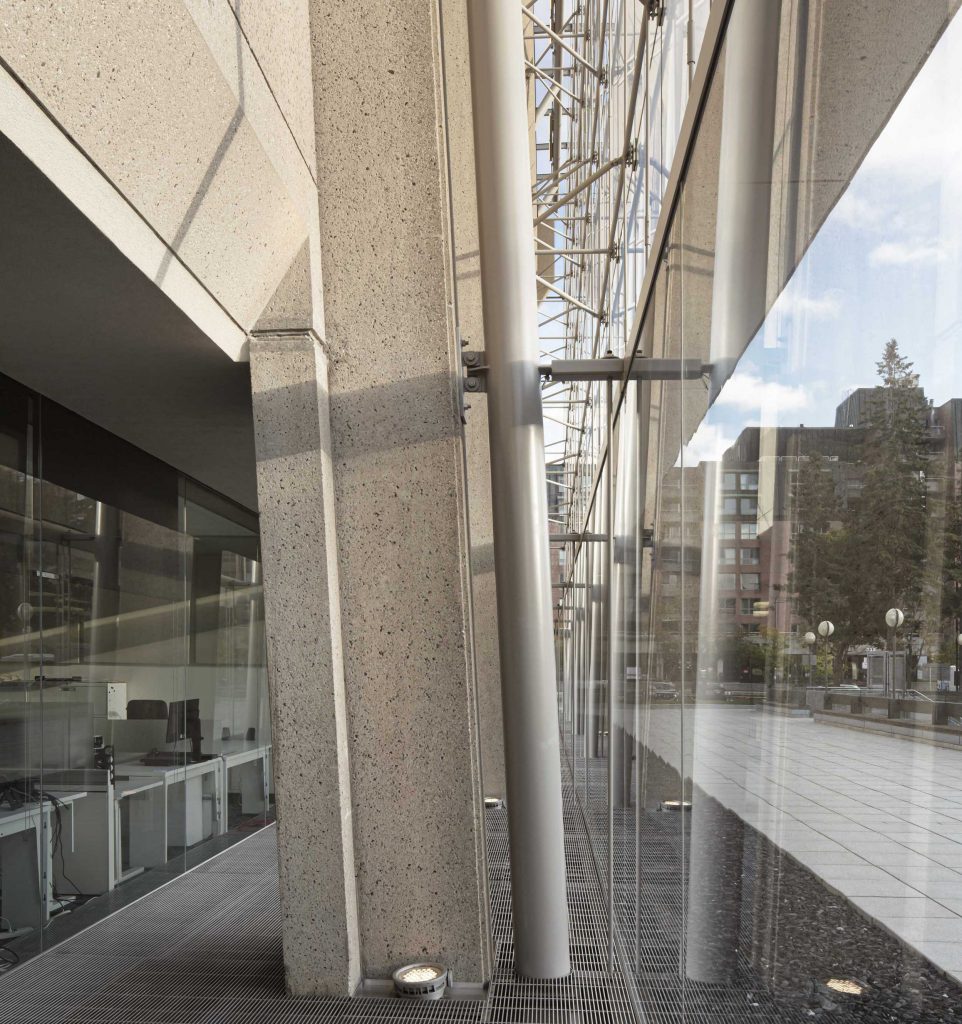
Close-up view of glass panels and steel skeleton structure that is offset from original concrete façade. Photographed by: Stephane Groleau.
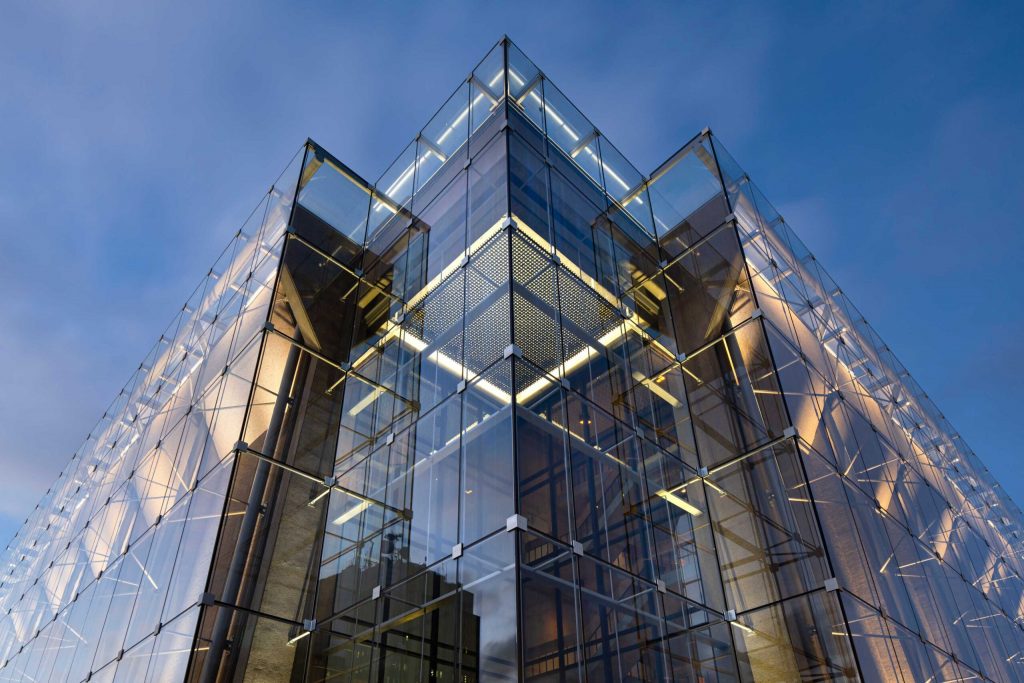
View of glass infill panels that make up the secondary building envelope by also allow for reflection into the original Brutalist structure designed by Victor Prus. Photographed by: Stephane Groleau.
Assessment and measurement

Retrieved from: https://www.isglobal.org/en/-/sdgs-and-global-health
In this section, the sustainability of The Grand Theatre is assessed by the United Nations Sustainable Development Goals (2015) and relevant Targets for the site.
| UN Sustainable Development Goal | Target | Assessment of Site |
|---|---|---|
| SDG 8 – Decent work and Economic Growth | Target 8.2 – Achieve higher levels of economic productivity through diversification, technological upgrading and innovation including through a focus on high-value added and labour-intensive sectors. Target 8.9 – By 2030, devise and implement policies to promote sustainable tourism that creates jobs and promotes local culture and products. | The introduction of StudioTelus and diversification of programming offered in recent years has led to higher levels of economic productivity. The rehabilitation done in 2017 was a technological upgrade that will keep the theatre operational for many more years. The Theatre actively works to showcase local Quebecois culture and talent which attracts tourists visiting Quebec City. |
| SDG 9 – Industry Innovation and Infrastructure | Target 9.4 – By 2030, upgrade infrastructure and retrofit industries to make them sustainable, with increased resource-use efficiency and greater adoption of clean and environmentally sound technologies and industrial processes, with all countries taking action in accordance with their respective capabilities. | The addition of glass panels and steel structures on the exterior of The Grand Theatre to create an encasement showcases how the site was retrofitted to make more sustainable and use less resources. |
| SDG 11 – Sustainable Cities and Communities | Target 11.4 – Strengthen efforts to protect and safeguard the world’s cultural and natural heritage | The site is a testament to Quebec’s cultural heritage and will continue to sustain its cultural heritage programming and the building itself. |
| SDG 12 – Responsible Consumption and Production | Target 12.5 – By 2030, substantially reduce waste generation through prevention, reduction, recycling and reuse | By coming up with an innovative plan to restore the building, Lemay and Atelier 21 used the existing building as opposed to demolition and starting with new materials. |
Works cited
This case study makes extensive use of the Grand Théatre de Québec website, including:
- Grand Theatre Quebec. Our History.
- Grand Theatre Quebec. Rooms – Theatres and other rental spaces.
Articles
- De Pauw, Carine. SABMag. Grand Theatre De Quebec : Conservation and Rehabilitation – Quebec City, QC, July 15, 2021.
- FLOORNATURE. The new facade on the Grand Theatre de Quebec, designed by the Lemay and Atelier 21 studios.
- The Plan. The Grand Theatre De Quebec’s New Glass Envelope: A Real Innovative Architectural Solution.
Websites
- Design Nuance. Lemay and Atelier 21 Designs New Sustainable Envelope for the Grand Theatre De Quebec.
- Durocher, Rene. The Canadian Encyclopedia. Quiet Revolution. March 4, 2015.
- Morgan, KC. INHABITAT. The Preservation and restoration of Quebec’s Grand Theatre, May 20, 2021.
- Musee National Des Beaux-Arts Du Quebec. Jordi Bonet – Celebration for the 50th Anniversary of the Grand Theatre De Quebec
- Native Land Digital. Territories / Wendake – Nionwentsio.
- Poirier, Lucien. The Canadian Encyclopedia. Grand Theatre de Quebec, December 15, 2013.
- Pomerleau. Grand Theatre de Quebec.
- Potvin, Gilles. The Canadian Encyclopeda. Ministere des Affaires culturelles du Quebec, December 15, 2013.
- Shiell, Allie. Archello. Award-winning Grand Theatre de Quebec attracts recognition for its beauty and sustainability, May 15 2021 .
- Taylor, Rachelle. The Canadian Encyclopedia. Conservatoire de musique et d’art dramatique du Quebec, December 16, 2013.
- UNESCO. What is Intangible Cultural Heritage.
- Venne, Jean-Francois. Ordre des Architectes du Quebec. The Grand Theatre de Quebec: brutalism clad in glass.
- Rapport de la consultation du ministre des Affaires culturelles du Québec (Quebec City 1982)